(2) Promotion of Universal Health Coverage, and Infectious Diseases Control
Universal health coverage (UHC) ensures that all people obtain the health services they need without suffering from financial hardship when paying for them. Japan considers that UHC is vital to achieve the health-related targets of the SDGs in the 2030 Agenda for Sustainable Development, the succeeding framework to the MDGs, and to narrow the disparities in healthcare services, to meet the health needs of all people, and for aid recipient countries to review and respond to their health challenges. Japan thus sets UHC as the core concept of its international health cooperation and carries out relevant efforts.
Infectious diseases, such as HIV/AIDS, tuberculosis, and malaria, as well as emerging and reemerging infectious diseases,* such as influenza and Ebola virus disease seriously affect the health of individuals and the socio-economic development of developing countries.
Moreover, since the spread of infectious diseases has impact that could extend beyond national borders, it requires the international community to work as one to address this. Japan engages in the implementation of countermeasures in close cooperation with the relevant countries and international organizations.
< Japan’s Efforts >
| Universal Health Coverage (UHC)
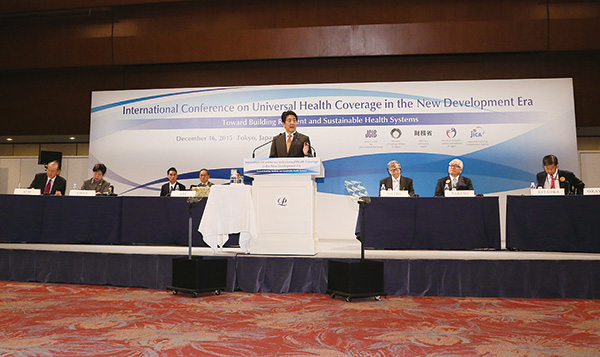
Prime Minister Shinzo Abe delivers a statement at the International Conference on Universal Health Coverage in the New Development Era held in Tokyo in December, 2015. (Photo: Cabinet Public Relations Office)
Based on Japan’s Strategy on Global Health Diplomacy, Japan has taken steps to mainstream UHC as part of the “Japan Brand,” shared Japan’s expertise, supported the improvement of health and economic growth in developing countries, and aimed to increase Japan’s global presence. Prime Minister Shinzo Abe announced Japan’s commitment to promoting UHC in his address to the UN General Assembly and at a side event. Japan also steered the discussions to promote UHC at UN negotiation fora, including the negotiations on the 2030 Agenda for Sustainable Development. As a result of these efforts, UHC was included as the key target of the new 2030 Agenda for Sustainable Development. The importance of UHC gained a global consensus.
One of the actions listed in Japan’s Strategy on Global Health Diplomacy is “Advance UHC in Africa,” which consists of health systems, strengthening maternal and child health promotion, and effective infectious disease control. Based on this policy, Japan implements a range of projects towards UHC primarily in Africa through technical cooperation and ODA Loans. Japan extends similar cooperation in Asia as well. The Healthcare Policy states that in light of Japan’s Strategy on Global Health Diplomacy, Japan will position global health as a key area of Japan’s diplomatic relations and promote UHC.
In September 2015, the Japanese government approved the Basic Design for Peace and Health under the Development Cooperation Charter. The Basic Design aims to mainstream UHC in the international community. It outlines that Japan would promote cooperation that capitalizes on its experience, technology, and expertise, including through physical assistance, such as building hospitals and supplying medicines and medical devices, and through non-physical assistance, such as human resources development and institution building. The Basic Design aims to achieve UHC that will “leave no one behind,” including poor people, children, women, persons with disabilities, senior citizens, refugees and internally displaced persons (IDPs), and ethnic and indigenous people.
Basic health services under UHC comprise all services ranging from nutritional improvement, vaccination, maternal and child health, sexual and reproductive health, infectious disease control, non-communicable disease control, and comprehensive community care and nursing care for senior citizens.
For nutritional improvement, Japan has provided bilateral assistance through the frameworks of maternal and child health and the training of healthcare professionals. Japan also extends multilateral assistance by way of cooperation through contributions to UNICEF and WFP. In other initiatives, Japan has contributed to the international nutritional improvement effort, Scaling Up Nutrition (SUN), since its launch in 2009 through contributions to the World Bank. In recent years, Japan has put efforts into implementing nutritional improvement programs in collaboration with private companies. In March 2015, the government established the study team for overseas promotion of Japanese nutrition-sensitive business under the Headquarters for Healthcare Policy. The team conducts studies to further promote private-public initiatives.
Vaccines are a means for combating infectious diseases with proven effectiveness and low cost, and it is estimated that 2 to 3 million lives could be saved each year by vaccination.(Note 26) However, as many as 21 million children are unable to receive the necessary vaccines. Since its first contribution in 2011 to Gavi, the Vaccine Alliance,* which was established in 2000 to improve the immunization rate in developing countries, Japan has provided a total of approximately $53.8 million to this Vaccine Alliance. Gavi estimates that, in 15 years since its launch in 2000, 440 million children have been immunized with Gavi-supported vaccines and 6 million deaths have been averted. It aims to immunize a further 300 million children from 2016 to 2020 to save over 5 million lives. As for bilateral assistance, Japan will contribute to increasing the vaccination rates by providing assistance such as for vaccine production and management, as well as for cold chain maintenance and management.
Maternal and child health, which is included in the MDGs (Goal 4: reduce the under-five mortality rate; Goal 5: improve maternal health), has made significant gains, including the reduction of the under-five mortality rate and the maternal mortality rate, and increase in the percentage of births assisted by skilled midwives. Nevertheless, the relevant MDGs were regrettably not achieved, and maternal and child health remains a significant challenge also in the SDGs. The Japanese government aims to strengthen the schemes for providing comprehensive and continuous maternal and child care. In this regard, the government aims to provide assistance focused on strengthening sustainable health systems* based on the principles of ensuring the ownership of developing countries and increasing their capabilities. In pursuit of these aims, the government implements efficient assistance in such countries as Ghana, Senegal, and Bangladesh. Through such assistance, Japan contributes to making the necessary services more accessible for women during pre-pregnancy (including adolescence and family planning), pregnancy, and delivery and for infants and children. In aid recipient countries, Japan works with other development partners, such as the United Nations Population Fund (UNFPA) and the International Planned Parenthood Federation (IPPF), to promote maternal and child health that includes sexual and reproductive health services such as family planning, and thereby improving the health of more women and children.
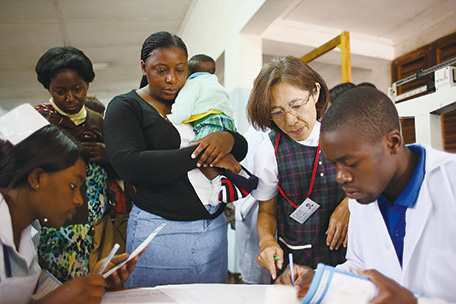
A Senior Volunteer, Ms. Tamiko Umeki works as a nurse at the Maternal Child Health Center at Chilenje Clinic, Zambia. In addition to provision of mobile medical care, Ms. Umeki engages in medical examinations of young children under the age of six and guidance to medical interns at the Maternal Child Health Center. (Photo: Atsushi Shibuya / JICA)
| The Three Major Infectious Diseases (HIV/AIDS, Tuberculosis, and Malaria)
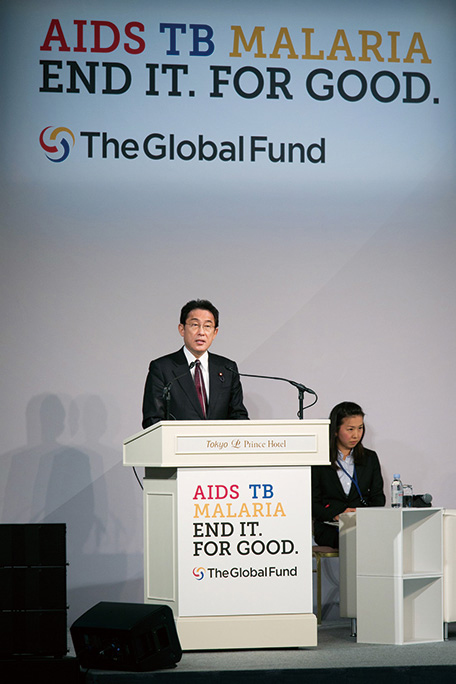
Foreign Minister Fumio Kishida delivers the opening statement at the 5th Replenishment Preparatory Meeting of the Global Fund to Fight AIDS, Tuberculosis and Malaria held in Tokyo on December 17, 2015. (Photo: Yuki Kato)
Japan attaches great importance to supporting activities to fight the three major infectious diseases (HIV/AIDS, tuberculosis, and malaria) through the Global Fund to Fight AIDS, Tuberculosis and Malaria (the Global Fund). The Global Fund was established as an organization to provide funding to tackle these three major infectious diseases following the discussions on measures against infectious diseases at the G8 Kyushu-Okinawa Summit in 2000 under Japan’s presidency. As one of its founders, Japan has provided financial assistance to the Global Fund since its establishment in 2002, and contributed approximately $2.35 billion to the Global Fund by the end of March 2015. It is estimated that support by the Global Fund has saved more than 17 million lives. Furthermore, in December 2015, Japan hosted the Global Fund’s Fifth Replenishment Preparatory Meeting in Tokyo, and contributed to the discussions on the future direction of the Global Fund’s activities, including the 2017-2019 activities and financing demands. Additionally, Japan provides supplemental bilateral aid through its own program to developing countries receiving aid from the Global Fund, in order to ensure that measures against these three major infectious diseases are implemented effectively in those recipient countries. Japan also strives to strengthen the linkage between the support from the Global Fund and the improvement of health care systems, community empowerment, and the policies for maternal and child health in those countries.
As bilateral assistance for HIV/AIDS countermeasures, Japan is providing assistance to spread knowledge to prevent new infections, raise awareness, widely provide testing and counseling, and enhance the distribution system of drugs to treat HIV/AIDS. In particular, JOCV on Infectious Disease and HIV/AIDS Control are vigorously engaged in activities such as the spreading of knowledge and understanding of prevention, as well as the care and support of people living with HIV/AIDS, mainly in Africa.
With regard to tuberculosis, Japan’s assistance has been focusing on those priority countries needing action, as well as those countries where the spread of the disease is deemed to be serious, as designated and recognized by WHO in accordance with the Global Plan to Stop TB 2006-2015. In these countries, Japan has been promoting a series of measures to fight tuberculosis, including the aspects of prevention, early detection, diagnosis and continuing treatment, as well as those measures to address co-infection of HIV/AIDS and tuberculosis. In July 2008, the Ministry of Foreign Affairs (MOFA) and the Ministry of Health, Labour and Welfare (MHLW) announced the Stop TB Japan Action Plan, which was developed jointly with JICA, the Japan Anti-Tuberculosis Association, and the Stop TB Partnership Japan. Making use of the experience and technology fostered through its domestic tuberculosis countermeasures, and with the public and private sectors working closely together, Japan has strived to contribute to the reduction of the annual number of deaths from tuberculosis in developing countries, particularly in Asia and Africa, setting the target at 10% reduction of the number worldwide (160,000 people, based on 2006 figures). Based on the Global Plan to Stop TB 2011-2015 revised in 2010, Japan revised its own Stop TB Japan Action Plan in 2011. In addition, based on the new global strategy that WHO adopted in 2014 with the target years for achievement set between 2015 and 2035 (Global strategy and targets for tuberculosis prevention, care and control after 2015), Japan re-revised the Action Plan in July 2014 and confirmed that it would continue to work on measures against tuberculosis on a global level.
With regard to malaria, a major cause of infant mortality, Japan provides assistance for initiatives for anti-malaria measures involving the strengthening of local communities and assistance in cooperation with the United Nations Children’s Fund (UNICEF).
| Infectious Diseases Other than the Three Major Infectious Diseases (e.g., Polio, Neglected Tropical Diseases)
Strengthening measures against new strains of influenza, tuberculosis, malaria, and other emerging and reemerging infectious diseases,* as well as ramping up for the final stage of initiatives to eradicate polio, continue to require international efforts. Furthermore, “Neglected Tropical Diseases”* such as Chagas disease, Filariasis, and Schistosomiasis affect approximately 1 billion people worldwide, and cause major socio-economic loss in developing countries. Since infectious diseases spread and have impact beyond national borders, the international community must work as one to combat them. Japan is engaged in the implementation of countermeasures in close cooperation with the relevant countries and international organizations.
| Polio

The signing ceremony for the agreement to support the polio eradication campaign in Nigeria between JICA and the Bill & Melinda Gates Foundation held via a video conference system connecting JICA (Tokyo) with the Gates Foundation (the US). (Photo: JICA)
Polio is in the final stage of eradication. Japan works mainly in cooperation with UNICEF to eradicate polio with a focus on three polio-endemic countries (countries where wild polio has never been eradicated and is still spreading)—Nigeria, Afghanistan and Pakistan. In Pakistan, Japan has provided assistance exceeding a cumulative total of more than ¥11 billion in coordination with UNICEF since 1996. In addition, in August 2011, Japan partnered with the Bill & Melinda Gates Foundation from the private sector to provide a nearly ¥5 billion ODA Loan. Loan Conversion was adopted as a new approach for this ODA Loan. Under this approach, the Gates Foundation repays the debt owed by the Pakistani government when targets are achieved. Following the confirmation of project outcomes including the attainment of a high vaccination rate, the Gates Foundation repaid the loan on behalf of the Pakistani Government in April 2014. With the same approach, in FY2014, Japan provided an approximately ¥8.3 billion ODA Loan for the “Polio Eradication Project” in Nigeria. Furthermore, in FY2014, Japan provided approximately ¥1.45 billion and ¥560 million respectively to Afghanistan and Pakistan where polio is endemic. It also provided approximately ¥220 million to Zambia, a non-endemic country. As an emergency measure to counter polio in Somalia, in FY2013, Japan provided ¥110 million to the country.
| Neglected Tropical Diseases (NTDs)
In 1991, Japan took the lead by launching a full-scale effort against Chagas disease, which is also known as a “disease of poverty,” in Central American countries. Japan provided assistance to establish a system for dealing with Chagas disease vectors and contributed to reducing the risk of infection. Regarding Filariasis, Japan supplies antiparasitic agents as well as educational materials to provide knowledge and understanding to a large number of people. Meanwhile, Japan also conducts preventive education through JOCV activities in order to reduce the number of new cases and maintain the non-epidemic status.
Furthermore, in April 2013, Japan launched the Global Health Innovative Technology Fund (GHIT Fund), the first public-private partnership in Japan with the purpose to facilitate the development of new drugs for treatment of infectious diseases in developing countries including NTDs. The GHIT Fund aims to control infectious diseases in developing countries through the research and development (R&D) of low-cost and effective therapeutic medicine, vaccines, and diagnostic products, while promoting global cooperation with research and development institutions both inside and outside Japan.
| Public Health Emergencies (Ebola Virus Disease)
In the current globalized world, infectious diseases spread across national borders easily and bring serious impacts to the entire international community. The epidemic of the Ebola virus disease (EVD) in 2014 took many lives in the three countries of Guinea, Liberia, and Sierra Leone, and resulted in the spread of infection to neighboring countries and the secondary infection of medical personnel. The epidemic led to WHO to declare a Public Health Emergency of International Concern (PHEIC) and the UN Security Council to adopt a resolution (Resolution 2177), which was the third resolution in the Security Council’s history concerning infectious diseases. As these responses suggest, bringing an end to the EVD outbreak was a major humanitarian, economic, and political challenge for the international community.
In April 2014, Japan became one of the first countries to provide emergency grant aid to Guinea in response to the EVD outbreak. Since then, Japan has provided seamless assistance to the affected countries and international organizations. By June 2015, Japan provided financial assistance totaling approximately $184 million as well as dispatched experts and provided relief goods. As regards human assistance, Japan dispatched experts on 20 occasions to WHO missions as of June 2015, and dispatched medically licensed MOFA staff to the UN Mission for Ebola Emergency Response (UNMEER). In regard to material assistance, Japan provided relief goods to affected countries, including personal protective equipment (PPE). Japan has also implemented public-private efforts against the Ebola crisis, including developing medicine, rapid test kits, and thermography cameras that leverage Japanese technologies. (For more information on Japan’s efforts, see “ODA Topics”.)
The weak health systems in the region are considered to be one of the factors behind the EVD epidemic. Building a sustainable and resilient health system is crucial to control infectious diseases. Based on this view, from before the EVD outbreak, Japan has prioritized development cooperation for health, an issue that is directly linked to human security, and has continuously striven to enhance health systems in West Africa under the banner of promoting UHC. Japan provides health assistance that includes assistance for the capacity enhancement of medical personnel and the development of healthcare facilities, in line with the recovery plan that the three affected countries newly formulated. In addition, Japan swiftly implements assistance that contributes to their social and economic recovery, including assistance for infrastructure development, agricultural productivity improvement, and food security enhancement. Japan continues to undertake medium- to long-term efforts, making use of the $500 million assistance and training assistance for 120,000 human resources in the health sector in Africa announced at TICAD V in 2013.
Based on the Basic Design for Peace and Health, Japan, as a nation that proactively contributes to the peace and prosperity of the international community, and as a nation that leads the international health discussions including at the G7/8 summit and TICAD, aims to end and prevent the recurrence of EVD outbreaks. Furthermore, the Basic Design outlines Japan’s commitment to working collectively with the international community to build a global response system against public health emergencies aimed at preventing, detecting, and responding to various infectious diseases. Japan has newly established a Japan Disaster Relief Infectious Disease Response Team to swiftly provide human assistance to the affected countries, as part of the efforts to provide effective assistance.

Training for medical professionals at Khartoum International Airport, the point of entry to Sudan, provided in order to support the country’s efforts to prevent and control the spread of Ebola disease. In the photo, a Japanese expert provides instructions on how to put on Personal Protective Equipment. (Photo: Kunikazu Akao / JICA Sudan)
- *Emerging/reemerging infectious diseases
- “Emerging diseases” are infectious diseases which were not previously known and have been newly recognized in recent years, such as SARS (Severe Acute Respiratory Syndrome), avian influenza, the Ebola virus disease, and others.
“Reemerging diseases” are infectious diseases that had spread throughout the world in the past and subsequently saw a decrease in the number of cases, but have been on an increasing trend again in recent years such as cholera and tuberculosis. - *Gavi, the Vaccine Alliance
- Gavi, the Vaccine Alliance is a public-private partnership, which was established with the aim to save children’s lives and protect people’s health by increasing access to immunization in developing countries. In addition to the governments of donor countries and developing countries as well as relevant international organizations, the pharmaceutical industry, private foundations and civil society participate in this partnership.
- *Health system
- “Health system” refers to a framework for the delivery of health services that includes government systems, healthcare facilities, medicine supply, healthcare information, financial administration, and acquisition of financial resources, as well as personnel to operate these processes and provide services.
- *Neglected tropical diseases
- “Neglected tropical diseases (NTDs)” include Chagas disease, dengue fever, Filariasis, and other diseases that are transmitted from parasites, bacteria, etc. The number of infected individuals has reached approximately one billion worldwide, with some cases resulting in death, notwithstanding that many of these diseases could either have been prevented or eradicated. In addition, as many of the cases are found among the poorest segment of the population in the affected countries, social awareness of this issue is relatively low. Therefore, the development of diagnostic methods, treatment and new drugs, and the process of making them available to those in need is lagging. The importance of NTD countermeasures was confirmed at the G7 Summit in Schloss Elmau, Germany in 2015.
- Note 26: Source: WHO, “Health topics, immunization” http://www.who.int/topics/immunization/en
The Philippines
The Project for Cordillera-wide Strengthening of the Local Health System for Effective and Efficient Delivery of Maternal and Child Health Services
Technical Cooperation Project (February 2012 – Ongoing)
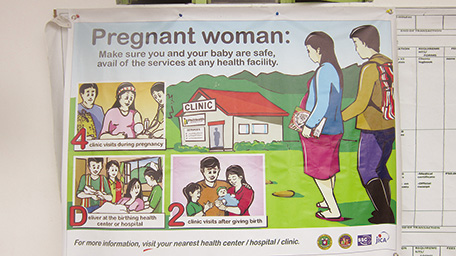
Publicity materials to raise awareness regarding hospital delivery and prenatal and postnatal medical checkups. (Photo: JICA)
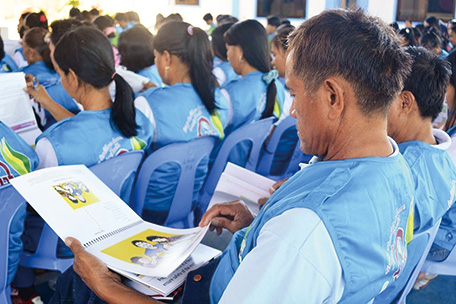
Consultations with the Department of Health Center for Health Development – CAR, which is JICA’s main counterpart in the project. (Photo: JICA)
The Cordillera Administrative Region is located in the northern part of Luzon Island in the Philippines. Indigenous peoples make up 70% of Cordillera’s population. They live in mountainous areas, and have their own languages and cultures. The region is also geographically isolated and has a high rate of poverty. Therefore, Cordillera urgently needs to develop a healthcare system to improve local residents’ access to health services.
This region also had a high maternal and child mortality rate because many women gave birth at home. Only 55% of deliveries were made in medical facilities in 2009, prior to the implementation of this project.
In order to deal with these issues, the Government of Japan launched a project to strengthen the regional health system in 2012. This project has opened new hospitals, maternity homes, and healthcare centers, in order to improve maternal and child health services. It has also provided birthing tables and other medical equipment to existing medical facilities.
In addition, Japan supported the facilities in installing equipment and employing doctors, nurses and midwives. As a result, the facilities have obtained accreditation from Philippine health insurance companies to receive reimbursement for providing medical services.
Cordillera also aims to provide insurance coverage for all expectant mothers, and is helping these women enroll in national health insurance. As a result, expectant mothers no longer need to worry about birth-related medical expenses, and can give birth safely, and receive pre-natal and post-partum exams in medical facilities. Furthermore, women from the community health team work as volunteers to raise awareness among expectant and nursing mothers.
More people in Cordillera use medical facilities now, thanks to their convenience and reliability. As a result, the rate of births that take place in medical facilities has risen to 95%. In addition, nearly all mothers have enrolled in national health insurance. They have also received a notebook for recording maternal and child health. This has encouraged them to manage their own health and the health of their babies with greater interest.
Japan is promoting universal health coverage (UHC) throughout the international community. UHC ensures access to basic health services for all, when they are needed and at an affordable cost. UHC is a crucial concept also in the field of maternal and child health. UHC is spreading across the Cordillera Administrative Region in the Philippines. (As of August 2015)
